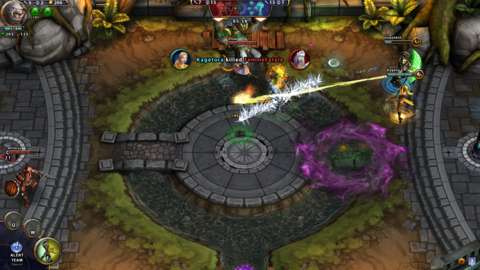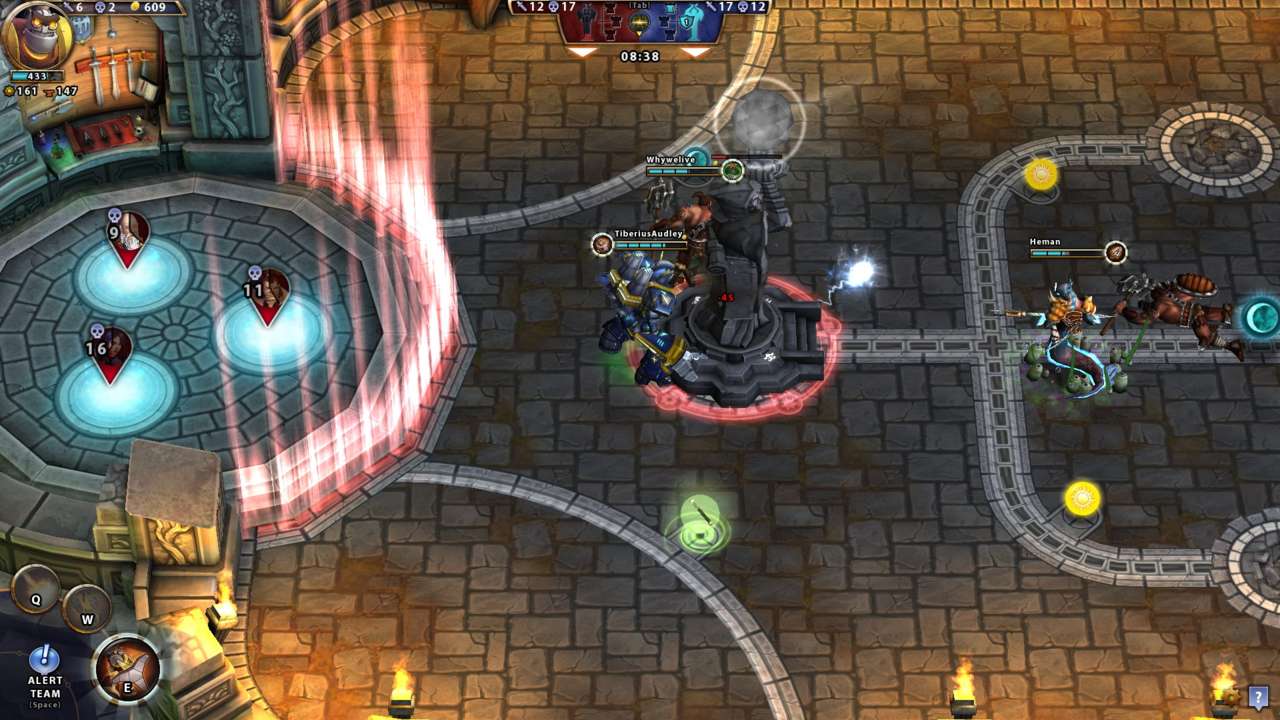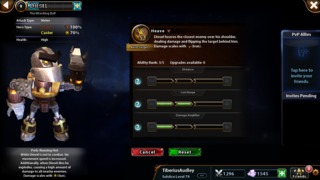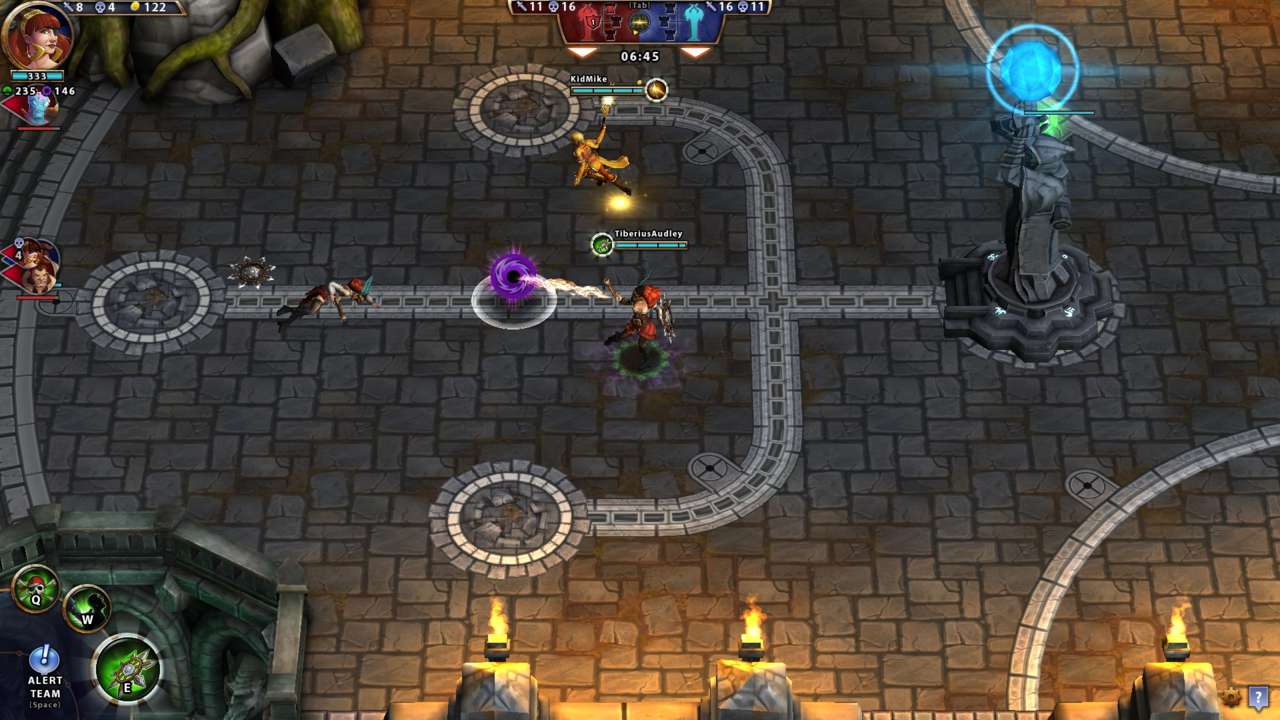In a genre where clones and knockoffs are the norm, Solstice Arena is a bright, refreshing beacon. In its entry into the multiplayer online battle arena foray, Zynga has created a fun and breezy game that has the same feel as Dota and League of Legends, but is played in brief 5- to 15-minute spurts rather than taking the better part of an hour. With the free-to-play "speed MOBA" Solstice Arena, the developer has proven it has the chops to compete with the big boys.
Solstice Arena puts you in a three-versus-three battle with the all-too-common final goal of destroying the enemy base. Each team's guardian is guarded by three towers. But rather than forcing you to wait on heroes to grind by killing minions and siege towers alongside an army, the game abandons both the concept of in-match levels and minions altogether. Instead, gold is earned through pickup style power-ups and a single capturable chest in the middle of the map.
You must establish control of the center of the map to capture the chest through a sort of channeling mechanism that slowly turns the chest toward your side. That channel can be instantly interrupted by even a heavy sigh from the opponents, however. So each team of three dances precariously around the chest, waiting for the perfect moment to engage. Whether that engagement comes when the giant ogre leaps onto a defenseless mage or the steam-powered robot launches his arm to hook your assassin into the tower and nonchalantly throw him over his shoulder, rest assured the engagement will happen, and it will be over quickly.
Earth, moon, sun, void, and iron. While Captain Planet won't be summoned by the combination of these, you have to find the perfect combination to maximize their potential.
Spells and abilities in Solstice Arena have only one casting resource: cooldowns. This means there's no waiting around for your mana to recharge and no waiting to build enough fury to reach the optimal moment of attack. That moment is ready and waiting when all three of your abilities are off cooldown. The action is nearly constant, and in the 12 minutes it takes to play a match, it's rare that standoffs take more than half a minute.
You can purchase items from the spawn platform to improve your character's abilities. Rather than deciding which items from the whole arsenal you'd like as in other MOBAs, you're given a choice of one head item, an accessory, an off-hand, a weapon, boots, and body armor, and you may carry only one of each. Most items grant you only two of the game's five attributes, and each item has three base choices that can be upgraded into three final tier-three choices, each with a different passive enhancement that can greatly improve your character's fighting potential. Bludgeons help you keep a target in place, robes improve the caster's damage or healing, and belts help you wear the pants in the family by making you immune to certain crowd-control abilities.

Earth, moon, sun, void, and iron. While Captain Planet won't be summoned by the combination of these, you have to find the perfect combination to maximize their potential. Each attribute is tied to a stat such as attack damage, movement speed, cooldown reduction, attack speed, or defense. In addition to earning them through items, you also earn attributes that spawn as capturable power-ups around the map and smaller bonuses through instant pickups.
One of the primary innovations to speed the game up is that you don't have to wait around for items and attributes to siege the enemy's base. Towers are active only while a player is alive and away from his or her spawn point. If an entire enemy team is dead, or if they have retreated to heal, their towers simply won't fight back. An early sweep of the enemy team results in a power play, guaranteeing some free time to begin pecking away at the tower's defenses. As the game goes on and respawn times get longer, these power plays become much more dangerous, and a full team being aced at the wrong time could result in a quick defeat.
The game is limited at present by its meager hero pool. With only 20 heroes to choose from, and steep costs to unlock them, things become redundant in longer play sessions. You see many of the same faces and same groups of faces over and over across your games. Zynga somewhat offsets this by offering a fair helping of heroes in a free trial rotation, which refreshes every few days, but playing with or against players who have not unlocked a hero of their own means that what you see is all trial heroes, all the time.

Fortunately, character designs are all quite different from one another, and each hero has a unique style. Whether that style involves playing from the back lines as a high-powered mage of the sun, or turning to stone and spinning through the ranks of your foes, or throwing down a music box to pacify your foes while you spin around healing your teammates, heroes have signature abilities, and there don't yet appear to be redundancies among them. Each ability can be upgraded between games, as winning (or participating) earns experience for that hero. Each skill has three different paths that can be upgraded, but only two may be selected for the five additional skill points put into each skill. You can use these upgrades to suit your gameplay whims, whether that means making areas of effect larger, making stun durations longer, or just making skills pack a bigger wallop when you connect with an enemy.
While I have been exclusively playing the PC version released on Steam, it's imperative to mention that this game is cross-platform with iOS and Mac. The three platforms are seamlessly integrated with one another, and at any given time your teammates or opponents could be playing on an iPad or iPhone while you sit at your computer with a mouse and keyboard. I was unable to discern in my play who was playing from what media, which speaks well of the cross-platform support. The mobile format suits the game's short, burst play sessions to allow those on the go to be able to squeeze in a game or two in transit before returning to their PC, or simply sitting on their couch and continuing to play on the iPad.
While the lack of rage-filled hate speech is welcome, the ability to educate players is sorely missed.
There are a few expected features missing from Solstice Arena. Tooltips for abilities can only be read outside a game, so there is no way to refresh your memory mid-game on what exactly an ability does. Because some nuanced effects, such as bonus damage, amplified damage, or damage reduction, aren't communicated clearly through visual effects, this can be problematic at times. Each hero also has a passive perk, which is unique to that hero. These can also be seen only at the character select screen, and are not visible anywhere in-game unless it grants a stat boost that is communicated in that player's buff bar during a match. I didn't know these perks existed until after several hours of playing.

Additionally, there is no in-game chat function. This means you needn't worry about toxic players who berate, blame, and insult teammates who underperform. However, you're unable to help out teammates who may be playing or building poorly. The only form of communication in the game is through a single ping every few seconds. You cannot tell your teammate, "Don't hook the spinning guy into our team," or say, "Hey, build Nullifying Belt," when your opponents have stacked a roster full of silences. While the lack of rage-filled hate speech is welcome, the ability to educate players is sorely missed.
Players looking for a deep, rich experience will find themselves stuck in the shallow end of the pool. The short encounters and matches make for a lack of substantial depth in the game. However, with the upgradable abilities and the various perks on each tier-three item, there are more effective item builds depending upon the opponent's composition, and playing the same way each time will not get the most efficient play out of your hero. Clever players are free to deviate from the recommended items in order to play their hero beyond its defined role, but with ability scaling tied directly to certain resources, there are some boxes you simply can't think outside of.

Solstice Arena is explosive fun, and its short matches quickly entice you into the "just one more game" mentality so common in compelling multiplayer experiences. And though the game is great for the PC, each match's brevity makes Solstice Arena a fantastic choice for gaming on the go. If you have an iOS device, get Solstice Arena. f you don't have an iOS device, get Solstice Arena for your PC. It's as simple as that. The 10 minutes you play at a time will quickly add up to hours you've invested into this delightfully fast MOBA experience.